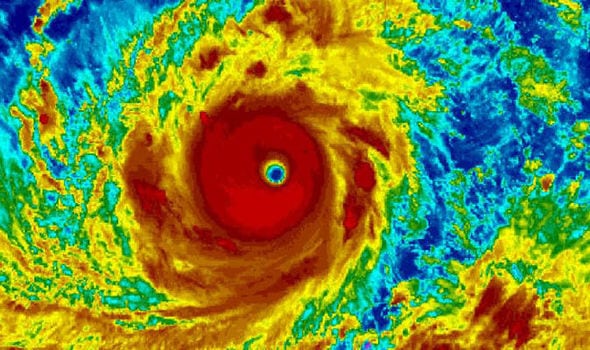 (Image Credit: NOAA
(Image Credit: NOAA
The Other Storm: Typhoon Mangkhut and Military Response
While much of the U.S. was (rightly) focused on Hurricane Florence, another storm battered the Philippines and Hong Kong. The equivalent of a Category 5 hurricane, Super Typhoon Mangkhut recently swept through Guam, the Philippines, and Hong Kong, causing widespread damage and killing hundreds.
The typhoon almost matched the strength of Typhoon Haiyan, the devastating storm in 2013 that killed over 7,300 people and displaced over five million people across the Philippines. The U.S. military played a major role in humanitarian response to Typhoon Haiyan (providing up to $37 million in aid and deploying the USS George Washington aircraft carrier). Today, the USS Wasp Expeditionary Strike Group with the 31st Marine Expeditionary Unit deployed to provide assistance in response to Typhoon Mangkhut and deployed over 13,000 servicemembers to respond to Hurricane Florence.
Well trained for such response and stationed across the globe, the U.S. military is often the first to deploy in crisis. Unfortunately, climate change will likely increase the need for such humanitarian efforts particularly in rapidly growing Southeast Asia. Further, if response is not effective, such storms have the potential to destabilize communities and increase instability further overtaxing our military readiness.
The aftermath of Typhoon Haiyan demonstrated the devastation a major storm can cause even in a region accustomed to multiple typhoons each year. The typhoon was “possibly the most powerful storm ever recorded” clocking in wind speeds at over 196 miles per hour with a storm surge of up to 23 feet and high water marks 46 feet above mean sea level. Estimates of damage from Haiyan range up to $13 billion. Typhoon Mangkhut will likely have similar economic impacts. Super Typhoon Mangkhut cut across the bread basket of the Philippines right before the start of the rice and corn harvest. Agricultural damage is currently estimated at $264 million. In a country already plagued with food insecurity due to high food prices and low wages, this typhoon was particularly ill-timed as the country is currently struggling with rice shortages.
Climate change adds to the intensity of storms like Hurricane Florence and Typhoon Mangkhut. Warming surface and water temperatures act as fuel for tropical systems (including hurricanes, cyclones, and typhoons). These storms become stronger, wetter, and more unpredictable. While communities may be adapted to hurricanes or typhoons as a part of a seasonal cycle, increasingly extreme storms make it harder for communities to bounce back, leaving them even more vulnerable for the next storm.
Vulnerable and insecure communities become ripe for instability. Farmers and fishers return to destroyed crops and infrastructure. In order to survive, they may be forced to find alternative sources of income or become one of the millions of Filipinos working abroad to send home remittances. Some countries have seen extreme droughts and collapse of crops lead to higher recruitment of individuals into terrorist organizations as that alternative source of income. An ISIS insurgency isn’t likely in the Northern Philippines after Typhoon Mangkhut. Still, the potential for instability and request for U.S. military support should not be underestimated.
Responding to such crises is an important and valuable contribution by the U.S. military to build goodwill worldwide and help countries maintain stability in crisis. But how far can we stretch our troops? Every storm to hit U.S. military installations forces the ships, aircraft and personnel to either move or hunker down. This undermines readiness as troops are busy preparing for incoming storms. Increasingly extreme storms will only exacerbate this concern. Beyond the impact to readiness, extreme storms could result in further troop deployments. Even if the U.S. provides initial response and aid, communities may struggle to rebuild, leaving them vulnerable to extremist groups that can leverage those grievances. This could lead to U.S. troops deploying to respond to instability in one more country.
Southeast Asia has developed some resilience to such storms and crises. Typhoon Haiyan provided a number of lessons for the Philippines, such as reinforcing ceilings with concrete beams and bolts that allow the roof to move slightly without blowing off during a storm. The United Nations High Commissioner for Refugees produced a comprehensive overview of the crisis and response plans. Implementing those plans prior to storms hopefully mitigated some of the impact of Mangkhut and U.S. military assistance should aim to align with those plans. Into the future, the U.S. military should prepare for the inevitable increase in both the physical storms themselves and the subsequent consequences of instability.





